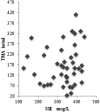Improving iodine nutritional status and increasing prevalence of autoimmune thyroiditis in children
- PMID: 28217504
- PMCID: PMC5240087
- DOI: 10.4103/2230-8210.195996
Improving iodine nutritional status and increasing prevalence of autoimmune thyroiditis in children
Abstract
Objective: The objective of this study is to evaluate the link between excess iodine intake as evidenced by increased urinary iodine excretion (UIE) and autoimmune thyroiditis in children and to assess the correlation between UIE and thyroid microsomal antibody (thyroid peroxidase [TPO]) titers in children.
Materials and methods: All children with goiter between age group 6 and 12 years, were subjected to blood tests for free thyroxine, thyroid stimulating hormone, and TPO antibody, fine needle aspiration was advised for all children with goiter. Forty-three children with confirmed autoimmune thyroiditis served as cases, and 43 children with euthyroid goiter with workup negative for autoimmune thyroiditis and iodine deficiency were enrolled as controls. UIE was estimated in spot urine sample for both cases and controls. The levels of urinary iodine were compared between cases and controls.
Results: The levels of urinary iodine were significantly higher in children with autoimmune thyroiditis as compared with control. There was a positive correlation between UIE and antimicrosomal antibody titers among cases. Among cases 65% children had subclinical hypothyroidism, 27.9% had overt hypothyroidism and 7% of cases, and 100% of controls had euthyroid functional status. Excessive (≥300 μg/L) UIE was strongly associated with autoimmune thyroiditis. If the UIE level is ≥ 300 μg/L, then there is 17.94 times higher chance of having amiodarone-induced thyrotoxicosis than those who have UIE level < 300 μg/L (P < 0.001).
Conclusions: A possible association between increased iodine intake and autoimmune thyroiditis was found in this study. Excessive iodine intake may trigger thyroid autoimmunity and eventually thyroid hypofunction.
Keywords: Hashimoto; iodine; thyroiditis.
Conflict of interest statement
There are no conflicts of interest.
Figures


Similar articles
-
Evaluation of thyroid functions with respect to iodine status and TRH test in chronic autoimmune thyroiditis.J Clin Res Pediatr Endocrinol. 2011;3(1):18-21. doi: 10.4274/jcrpe.v3i1.04. Epub 2011 Feb 23. J Clin Res Pediatr Endocrinol. 2011. PMID: 21448329 Free PMC article.
-
Iodine Status among Subclinical and Overt Hypothyroid Patients by Urinary Iodine Assay: A Case-Control Study.Indian J Endocrinol Metab. 2017 Sep-Oct;21(5):719-723. doi: 10.4103/ijem.IJEM_413_16. Indian J Endocrinol Metab. 2017. PMID: 28989881 Free PMC article.
-
Urinary iodine excretion and antiperoxidase enzyme antibody in goitrous and healthy primary school children of Arak, Iran.J Endocrinol Invest. 2007 Apr;30(4):274-8. doi: 10.1007/BF03346293. J Endocrinol Invest. 2007. PMID: 17556862
-
Multiple Nutritional Factors and the Risk of Hashimoto's Thyroiditis.Thyroid. 2017 May;27(5):597-610. doi: 10.1089/thy.2016.0635. Epub 2017 Apr 6. Thyroid. 2017. PMID: 28290237 Review.
-
The relationship between autoimmune thyroid disease and iodine intake: a review.Endokrynol Pol. 1992;43 Suppl 1:53-69. Endokrynol Pol. 1992. PMID: 1345585 Review.
Cited by
-
Should iodine supplementation be universally recommended for pregnant women in Brazil? A position statement from the Thyroid Department of the Brazilian Society of Endocrinology and Metabolism (SBEM).Arch Endocrinol Metab. 2025 Aug 26;69(4):e250170. doi: 10.20945/2359-4292-2025-0170. Online ahead of print. Arch Endocrinol Metab. 2025. PMID: 40857629 Free PMC article. Review.
-
Association of antithyroglobulin antibody with iodine nutrition and thyroid dysfunction in Nepalese children.Thyroid Res. 2019 Jul 9;12:6. doi: 10.1186/s13044-019-0067-z. eCollection 2019. Thyroid Res. 2019. PMID: 31320934 Free PMC article.
-
Iodine Deficiency: An under Recognized Problem.Indian J Endocrinol Metab. 2017 Jul-Aug;21(4):640-641. doi: 10.4103/ijem.IJEM_39_17. Indian J Endocrinol Metab. 2017. PMID: 28670556 Free PMC article. No abstract available.
-
Effect of Maternal Iodine Excess during Pregnancy on Neonatal Thyroid Function and Neurodevelopmental Status at 12 Weeks.J ASEAN Fed Endocr Soc. 2024;39(2):27-32. doi: 10.15605/jafes.039.02.12. Epub 2024 Aug 27. J ASEAN Fed Endocr Soc. 2024. PMID: 39620182 Free PMC article.
-
Spot urine iodine levels below the WHO recommendation are not related to impaired thyroid function in healthy children and adolescents.Eur J Nutr. 2021 Feb;60(1):493-502. doi: 10.1007/s00394-020-02268-3. Epub 2020 May 11. Eur J Nutr. 2021. PMID: 32390124 Free PMC article.
References
-
- Kapil U, Singh P. Current status of urinary iodine excretion levels in 116 districts of India. J Trop Pediatr. 2004;50:245–7. - PubMed
-
- Kapil U, Singh P, Pathak P. Current status of iodine nutriture and iodine content of salt in Andhra Pradesh. Indian Pediatr. 2004;41:165–9. - PubMed
-
- WHO/UNICEF/ICCIDD. Assessment of Iodine Deficiency Disorders and Monitoring their Elimination. WHO Document WHO/NHD/01.1. Geneva: World Health Organization; 2001.
-
- WHO/UNICEF/ICCIDD. Indicators for assessing iodine deficiency disorders and their control through salt iodization. WHO DocumentWHO/NUT/94.6. Geneva: World Health Organization; 1994.
LinkOut - more resources
Full Text Sources
Other Literature Sources

